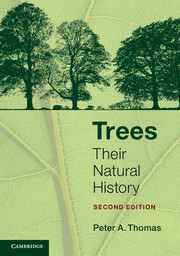Book contents
- Frontmatter
- Epigraph
- Contents
- Preface
- Chapter 1 An overview
- Chapter 2 Leaves: the food producers
- Chapter 3 The trunk and branches: more than a connecting drainpipe
- Chapter 4 Roots: the hidden tree
- Chapter 5 Towards the next generation: flowers, fruits and seeds
- Chapter 6 The growing tree
- Chapter 7 The shape of trees
- Chapter 8 The next generation: new trees from old
- Chapter 9 Age, health, damage and death: living in a hostile world
- Chapter 10 Trees and us
- Further Reading
- Index
- References
Chapter 10 - Trees and us
Published online by Cambridge University Press: 05 July 2014
- Frontmatter
- Epigraph
- Contents
- Preface
- Chapter 1 An overview
- Chapter 2 Leaves: the food producers
- Chapter 3 The trunk and branches: more than a connecting drainpipe
- Chapter 4 Roots: the hidden tree
- Chapter 5 Towards the next generation: flowers, fruits and seeds
- Chapter 6 The growing tree
- Chapter 7 The shape of trees
- Chapter 8 The next generation: new trees from old
- Chapter 9 Age, health, damage and death: living in a hostile world
- Chapter 10 Trees and us
- Further Reading
- Index
- References
Summary
Trees form the visual backdrop in most people’s lives whether in an urban or rural setting. In England alone we have more than 90 million trees outside of woodlands in either small groups, hedgerows or as individual trees. But of what value are they to us apart from enhancing our surroundings?
The value of trees
Over their long history, trees have played an important part in our lives that goes beyond just the supply of wood. Trees have been (and still are) sacred to many peoples; oaks were sacred to the European Druids, baobabs (Adansonia digitata) to African tribes, the ginkgo (Ginkgo biloba) to the Chinese and Japanese, sequoias (Sequoiadendron giganteum) to N American first people, and monkey puzzles (Araucaria araucana) to the Pehuenche people of Chile. Indeed, many of our words and expressions are derived from a close association with trees. Writing tablets were once made from slivers of beech wood (Fagus sylvatica), and ‘beech’ is the Anglo-Saxon word for book. Beech is still called ‘bok’ in Swedish and ‘beuk’ in Danish. Romans crowned athletes with wreaths of the bay laurel (Laurus nobilis); this was extended to poets and scholars in Middle Ages, hence Poet Laureate. Similarly, Roman students were called bachelors from the laurel berry (baccalaureus) leaving us with bachelor degrees (baccalaureate) and, since Roman students were forbidden to marry, unmarried bachelor males.
Information
- Type
- Chapter
- Information
- TreesTheir Natural History, pp. 376 - 386Publisher: Cambridge University PressPrint publication year: 2014
